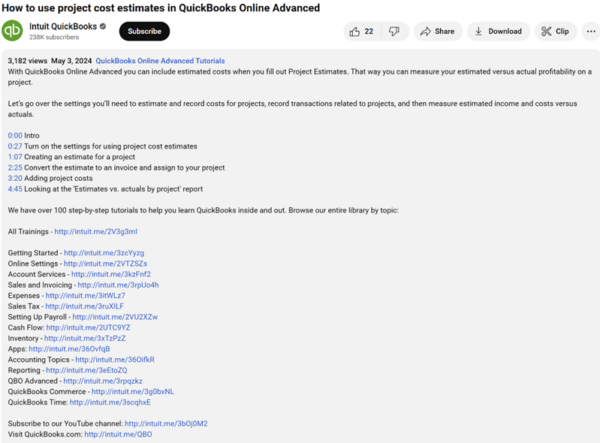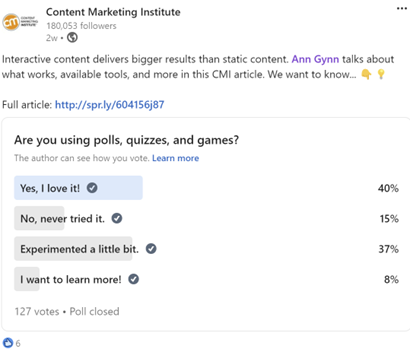Consumers really like short-form content.
Billions watch TikTok videos, YouTube Shorts, and Instagram Reels every month.
But it isn’t just consumers who like short content.
Google, YouTube, social media platforms, and more expect brief content. In meta descriptions, excerpts, episode descriptions, and sometimes posts. Some even set total character limits.
How do you make the most of those characters? Read on.
Meta descriptions
Some best-practices content says meta descriptions should be between 150 and 160 characters. Other sources say they can be up to 300 characters. Google says it doesn’t matter because it just selects the most relevant information from the meta description for the searcher, which usually appears as a truncated version.
But no matter what’s allowed, you still don’t have a lot of characters to convey the message, so you need to make the most of them.
To craft a meta description that really delivers, you need to think about what the searcher would want from the content. (Hopefully, you thought about that before the content was created, so it aligns with both business and audience intent.)
You shouldn’t need an in-depth analysis to understand the content’s purpose. Look at the designated keywords and categories. Organically incorporate the primary keyword (at a minimum) into the description. And detail what the searcher will get out of the content.
Here’s some of what Google says about perfecting the meta description:
- Create a short, relevant summary of the page.
- Treat it like a pitch to convince the user the page is exactly what they’re looking for.
- Craft unique descriptions for every valuable page.
TIP: You don’t need to write meta descriptions in sentence format; however, avoid stringing together keywords because they don’t give context for the content.
Here’s an example of bad and better from Google:
- Bad: “Eggs are a source of joy in everyone’s life. When I was a small child, I remember picking eggs from the hen house and bringing them to the kitchen. Those were the days.”
- Better: “Learn how to cook eggs with this complete guide in 1 hour or less. We cover all the methods, including over-easy, sunny side up, boiled, and poached.”
Example: Though I’m not a big fan of using examples from my work, in this case, I must because I can’t see the native meta descriptions (or excerpts) for content on other sites.
Let’s dissect the meta description for this CMI article, Interactive Content: How Quizzes, Games, and Polls Make for Engaging Results:
“Get your audience to stick and click with interactive content. Discover the possibilities, tools, and big results that many marketers are missing out on.”
The description totals 153 characters. It incorporates the primary keyword “interactive content.” As to its purpose, the category helped inform that. The article belongs to the content-creation category. So, the second sentence, “Discover the possibilities, tools …” delivers on that.
One more tip — be direct. Yes, I could have written, “Content marketers can get the audience to stick and click with interactive content. You can discover the possibilities ….” But I didn’t want that noun, “content marketers,” and pronoun, “you,” to take precious space. You don’t need to address the audience unless that’s critical for understanding or targeting.
Excerpts
Now, I see a lot of people simply paste their meta description into the excerpt field in WordPress or the corresponding category in whatever CMS they use. Excerpts can also be used as promo copy for newsletters, social media, and more.
In most cases, excerpts should not be the same as the meta description.
As WordPress explains, excerpts are summaries of longer articles that appear elsewhere on your site, such as a blog summary index or archived pages.
That means the person seeing an excerpt is already on your website. You aren’t asking them to pick your content over a competitor’s page that appears on the same search engine rankings page.
With that understanding, you can craft a more specific summary or highlight the content’s features that would attract someone to consume it.
Example: Here is the excerpt for the interactive content article:
“Host a poll. Do a quiz. Create a game. Interactive content comes in so many forms, but not enough marketers take advantage of it. Discover the possibilities, tools, and big results.”
The excerpt is a little longer than the meta description (about 30 characters or so). It’s also five sentences instead of two. Since I didn’t have to attract someone searching Google for information about how to do interactive content, I could be more specific on the article’s takeaway ideas — host a poll, do a quiz, create a game — before sharing the primary keyword (interactive content) and article overview.
One more tip — you don’t have to completely rewrite your meta description. As you can see in the example, the last sentence, “Discover the possibilities, tools, and big results,” is the same for both. Just make sure the excerpt delivers what an audience already on your site might want to know about the content.
YouTube descriptions
YouTube gives you 5,000 characters to describe your video. That’s the equivalent of about 800 to 1,000 words. But even Google, the owner of YouTube, advises against using all of them to explain the video.
Think of the description in two components — the text that appears before the clickable word “more,” and the text that appears in full after they click.
In the first part, include up to three keywords that reflect the subject matter, at least one of which appears in the title. That strategy makes sense, given YouTube is the second-largest search engine in the world.
With those words selected, spend your time crafting a few unique sentences (about 100 to 200 characters) to stand out. You’ll want to ensure that both a searcher and a subscriber of your channel can quickly understand what they’ll get from watching the video.
You should repeat the keywords in the second part of the description, according to Hootsuite’s helpful YouTube description guide.
Example: Let’s look at this video from Intuit QuickBooks — How To Use Project Estimates in Quickbooks Online Advanced.
The first part of its description reads:
“With QuickBooks Online Advanced you can include estimated costs when you fill out Project Estimates. That way you can measure your estimated versus actual profitability on a project.”
The first part totals 182 characters and succinctly explains the video’s topic (how to include estimated costs), the product (QuickBooks Online Advanced), and the benefit (measuring your estimated versus actual profitability). Intuit incorporates targeted keyword phrases — project estimates and QuickBooks Online Advanced.

When the user clicks on “more,” they see the full description. It totals about 1,500 characters — 18 times more than the preview but still far below the 5,000 characters permitted by YouTube.
The full description includes one more sentence on the specifics included in the video. Then, it shows the timestamps and chapters for the video to help viewers know when to tune into a particular topic.
Intuit also includes links to all its step-by-step tutorials broken down by subject matter before asking users to subscribe to the channel and visit the company’s website.

If you’re unfamiliar with how to add chapters and timestamps, YouTube provides instructions. At a minimum, you must include three chapters, each lasting at least 10 seconds.
One more tip — you can also further customize the description for easier reading by bolding, italicizing, or striking through the text. While YouTube doesn’t allow traditional bullets, you can use emojis to make your points easier to read.
Every social media platform embraces short-form posts. However, given the growing popularity of LinkedIn for B2B marketers, I wanted to focus on that platform. It may seem like a platform where you can write without caring about the character count. It isn’t.
LinkedIn lets individuals use up to 1,300 characters and companies up to 700 characters for posts to their pages. That sounds like a lot compared to meta descriptions, excerpts, and X.
But here’s the thing: LinkedIn shows only about 200 characters or less on the screen before the “see more” button appears.
So, you’re back to crafting a super short message. However, unlike meta descriptions and excerpts, your post may appear in the feed of LinkedIn audiences who aren’t actively searching and not even actively interested in your topic.
You have two choices: 1. Write a post that doesn’t require the reader to click to see more, or 2. Write a post (in less than 200 characters) that attracts the reader to click, and then deliver a brief narrative that makes them glad they did.
Either way, focus your time on the content that will appear in the feed. Create something visually and substantively pleasing to attract attention quickly. For example, use unexpected spacing by inserting line breaks and ellipses or incorporate a (relevant) emoji or two.
Example: In this LinkedIn post, CMI opted for a short post (about 165 characters) with two goals.
The text promotes the interactive content article by touting the topic’s benefit (“delivers bigger results than static content”) and explains what the reader will get (“what works, available tools, and more”). It’s designed to get readers to click on the article link that also appears in the post (the first goal).
But it also has a second purpose — getting the viewer to stop scrolling and take a poll. In 18 characters, it invites people to take a poll. (LinkedIn limits polls to four options. Keep the choices simple, or people won’t bother reading them, let alone vote in the poll.)

One more tip — if you use hashtags, make sure to budget space for those characters. Still, don’t go overboard. Scheduling software Hootsuite recommends no more than three hashtags, and I concur.
Stay short
In Shakespeare’s Hamlet, Polonius says, “Brevity is the soul of wit.”
In content marketing, brevity is the soul of digital content. Google wants it. YouTube likes it. LinkedIn prefers it. But just as importantly, audiences do, too.
So, the next time you craft that meta description, excerpt, video description, or LinkedIn post, don’t think about the upper character limits. Focus on doing just enough to satisfy your brand, the publishing channel, and your potential readers.
HANDPICKED RELATED CONTENT:
Cover image by Joseph Kalinowski/Content Marketing Institute

